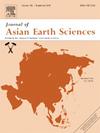Evolution of deep water circulation in the South China Sea since 32 million years ago
IF 2.4
3区 地球科学
Q2 GEOSCIENCES, MULTIDISCIPLINARY
引用次数: 0
Abstract
The closure of the Indonesian Gateway (IG)1 has played a pivotal role in influencing interocean circulation, notably affecting the Indonesian Throughflow (ITF) and altering climate patterns in Southeast Asia. However, there remains controversy regarding the timing of IG closure and its impacts on climate changes. In this study, we reconstructed Nd isotope (ƐNd) time series to observe the evolution of South China Sea (SCS) deep water over the past 32 Ma from core sediments at northern SCS and to explore the deep water connection between Indian Ocean and SCS before the fully IG closure.
The ƐNd time series of SCS deep water and benthic δ13C composition exhibits a remarkably consistent trend with North Indian Deep Water (NIDW) from 12 to 7 Ma, indicating that NIDW once served as a potential source. This feature implies a deep-water connection between the Indian Ocean and SCS deep water during this period. The observed ƐNd increases in SCS deep water during key intervals, such as ∼ 11, ∼16, and ∼ 25 Ma, likely link to a reduced contribution of LCDW to SCS deep water. Moreover, the Luzon Strait sill became the sole deep-water pathway into the SCS after IG closure. This restriction may have limited LCDW inflow, potentially intensifying its impacts on SCS deep water, as the LCDW contribution to the SCS has been linked to deep SCS carbon reservoirs. Future studies on high-resolution ƐNd records in SCS are necessary to explore the timing and climatic implications of this tectonic transition.

3200万年前以来南海深水环流演化
印度尼西亚门户(IG)1的关闭在影响洋间环流方面发挥了关键作用,特别是影响印度尼西亚通流(ITF)和改变东南亚气候模式。然而,关于关闭IG的时机及其对气候变化的影响仍存在争议。本文利用南海北部岩心沉积物重建Nd同位素(ƐNd)时间序列,观察了近32 Ma来南海深水的演化,并探讨了印度洋与南海在IG完全闭合之前的深水联系。在12 ~ 7 Ma期间,南海深水和底栖生物δ13C组成ƐNd时间序列与北印度深水(NIDW)具有显著的一致性,表明NIDW曾经是一个潜在的来源。这一特征表明在这一时期印度洋和南海深水之间存在深水连接。在关键时间间隔(如~ 11、~ 16和~ 25 Ma)观测到的南海深水ƐNd增加可能与LCDW对南海深水的贡献减少有关。此外,吕宋海峡仍然是IG关闭后进入南海的唯一深水通道。这一限制可能限制了LCDW的流入,潜在地加剧了其对南海深水的影响,因为LCDW对南海的贡献与南海深处的碳库有关。未来有必要对南海的高分辨率ƐNd记录进行研究,以探索这一构造转变的时间和气候含义。
本文章由计算机程序翻译,如有差异,请以英文原文为准。
求助全文
约1分钟内获得全文
求助全文
来源期刊

Journal of Asian Earth Sciences
地学-地球科学综合
CiteScore
5.90
自引率
10.00%
发文量
324
审稿时长
71 days
期刊介绍:
Journal of Asian Earth Sciences has an open access mirror journal Journal of Asian Earth Sciences: X, sharing the same aims and scope, editorial team, submission system and rigorous peer review.
The Journal of Asian Earth Sciences is an international interdisciplinary journal devoted to all aspects of research related to the solid Earth Sciences of Asia. The Journal publishes high quality, peer-reviewed scientific papers on the regional geology, tectonics, geochemistry and geophysics of Asia. It will be devoted primarily to research papers but short communications relating to new developments of broad interest, reviews and book reviews will also be included. Papers must have international appeal and should present work of more than local significance.
The scope includes deep processes of the Asian continent and its adjacent oceans; seismology and earthquakes; orogeny, magmatism, metamorphism and volcanism; growth, deformation and destruction of the Asian crust; crust-mantle interaction; evolution of life (early life, biostratigraphy, biogeography and mass-extinction); fluids, fluxes and reservoirs of mineral and energy resources; surface processes (weathering, erosion, transport and deposition of sediments) and resulting geomorphology; and the response of the Earth to global climate change as viewed within the Asian continent and surrounding oceans.
 求助内容:
求助内容: 应助结果提醒方式:
应助结果提醒方式:


